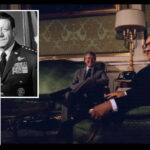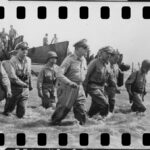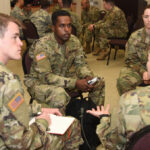
Experienced wargamers have traditionally been self-made through accumulated experience on the job.
In 2015, Deputy Secretary of Defense Robert Work wrote a memo to Pentagon leadership stating, “the Department’s ability to test concepts, capabilities, and plans using simulations and other techniques—otherwise known as wargaming—has atrophied.” This memo triggered a push for more wargames and, more importantly, more wargamers. Since the age of Kriegsspiel, a limiting factor of successful wargames has been the reliance on a knowledgeable core of wargaming designers, analysts, and facilitators. Today, leadership continues to demand wargames and new centers are standing up to serve that need; the demand for more knowledgeable wargamers far exceeds supply. The result is a bottleneck of too many games with limited experienced personnel.
Experienced wargamers have traditionally been self-made through accumulated experience on the job. Today, the wargaming community agrees that there has not been a systematic approach for acquiring, developing, and retaining the needed skills and knowledge to produce wargaming talent at the scale needed for the future. In this article, we present an approach, based on our experiences, which helps develop junior wargamers more efficiently, broadening the pool available. This is not a simple problem as wargamers need special skills and knowledge. Wargaming environments can be extremely tense; the wargame team must be capable of managing player personalities, explaining rules, supporting adjudication, and collecting thorough data for postgame analysis. That list excludes the skills needed to design wargames or the subject matter expertise needed to adjudicate results. The demand and need for such skills paired with the limited supply of experienced wargamers creates a significant gap that wargaming organizations cannot ignore.
As rising junior designers, we would like to share some of the efforts and activities we have experienced and found to benefit our wargaming careers. In our view, organizations should consider structuring their wargaming teams to embody a three-tiered apprentice-style approach of “See One, Do One, Teach One.” This traditional teaching method encourages incremental degrees of responsibility and difficulty as the trainee becomes comfortable at each tier, progressing toward more autonomy in the field. We will explore each of the three tiers before offering advice on opportunities outside the workplace.
“See One, Do One, Teach One”
The “See One” phase is focused on finding ways for junior staff to observe wargame design and project execution while minimizing the impact on limited staff time and funds. For wargaming teams, “see one” could include inviting junior analysts and designers to participate in and observe key project events of the gaming process, such as constructing the data collection management plan or the development of initial designs. Incorporating junior staff into these discussions will increase costs in staff time and project budget, but project teams benefit from greater diversity of feedback and junior staff grow their expertise and confidence through exposure.
At the Center for Naval Analyses (CNA) and the Institute for Defense Analyses (IDA), senior wargaming team members are expected to leverage junior wargaming staff to not only strengthen their own work through diversity of thought, but also to expose junior staff to different methodologies that they can use (and teach to others) in the future, creating a network of individuals in the organization who are familiar with wargaming terminology and concepts. As awareness spreads within the organization, wargaming project managers can leverage this newly informed network of staff for future projects, freeing up overtasked designers and wargamers.
In addition to seeing designs come to life, it is important for junior staff to also see the non-design components essential to the wargaming effort. These include logistical efforts, data collection, analysis of postgame results, and business development for future games. Supporting wargames in this manner can allow staff to cross-train as adjunct wargamers when full-time positions may not be available. This kind of participation is common across analytic organizations and provides a starting place for wargaming training. Given the high demand on senior staff to design games, develop business, and train new staff, having a professional cohort with foundational wargaming knowledge to support wargame activities can help free up senior wargamers’ time, which they can reinvest in their team and junior staff. However, relegating promising designers to supporting roles should be seen as a supplement to other, more direct, training methods as it does not guarantee the ability to execute broadly on all wargaming design tasks. Organizations will still need to allocate resources to facilitate junior designer’s opportunities to participate in key design tasks such as developing sponsor engagement, defining key research questions, scoping design, and translating a model into mechanics.
The next phase is “Do One.” It is key that organizational leadership ensure that junior staff have opportunities to facilitate and design different types of games, providing a well-rounded training experience while also highlighting what kinds of research questions are best studied under different wargaming lenses. Encouraging junior staff to “Do One” empowers them from an early stage to contribute to the game design phase, expanding the diversity of thought while increasing the quality of design. Leadership must balance exposing junior staff to more autonomy in design and allowing them to lead low-stakes projects with availability of senior designer to provide mentorship and assistance for issues as they arise.
The culmination of the three-tiered approach provides a platform for staff to demonstrate and solidify their competency through the ripple effect of “Teach One.” This step is essential to addressing the bottleneck of limited “master” wargamers needed to teach the onslaught of inexperienced designers. One of the ways to demonstrate this could be encouraging junior designer staff to lead informal meetings (such as a “brown bag” or “soapbox” session) on how to facilitate a structured analytic technique or on a project or topic they have worked on or are interested in. After empowering staff to “do one” it is essential that the skills that the organization has invested in are propagated throughout the establishment; this is the return on the investment.
These opportunities allow staff to learn and embody an organization’s philosophy and develop their professional network as well as business development opportunities.
At both CNA and IDA, mentorship of others is an explicit evaluation category for promotion, and teams are structured to provide learning opportunities both up and down the chain. No direct distinction is made in project milestone sessions between “junior” and “senior” staff, and colleagues are encouraged to freely ideate, giving new designers opportunities to assist other teams in understanding and solving their challenges. Other examples of “teaching one” include leadership encouraging junior staff to speak externally at conferences or panels, like Connections Wargaming Conferences, present a topic for graduate or undergraduate classes on campuses, or run demos of the organization’s available products. These opportunities allow staff to learn and embody an organization’s philosophy and develop their professional network as well as business development opportunities.
Benefits and Challenges
It can be difficult for organizations to invest in the “See One” phase of the approach as it requires increased costs of time and money with little immediate or perceptible output until the “Do One” phase is completed. Leaders should view the three-tiered approach as a pipeline of increasing exposure to concepts and growing confidence in their use. Returns on investment appear as new designers participate in low-risk events. This is seen in other apprenticeships and internships.
At IDA, junior designers are encouraged to participate in design scrums to practice their design skills in a low-stakes arena. During these scrums, participants are given brief exposure to the research question, one hour to sketch out a design for a game, and then receive feedback from their peers on their approach. Since there is only an hour to design, all designers treat the opportunity as a time to be creative and think differently about a topic rather than to produce a refined design concept. At CNA, junior designers are given the opportunity to facilitate an internal commercial game for peers and demonstrate CNA games in low-stakes external engagements like universities or conventions. In this environment, junior staff gain facilitation exposure using a game they know well while also receiving formal feedback on how to convey information. Offering more formal opportunities for creative development, such as the microgame design challenge at CNA or the IDA Microgame Project, also fosters professional development and game design credentials. More examples of low stakes “do one” opportunities include facilitating a smaller section or table discussion of a larger game or leading subtasks for a given project. These opportunities identify both strengths that new designers could lean into and weaknesses that require attention and training. Ultimately, these smaller, low-stakes opportunities build the skills to lead larger projects with limited to no oversight.
Supporting Wargamer Development
At CNA, short “lunch-and-game” type events are held on a regular basis and are selected to support topics relevant to ongoing work. At IDA, leadership has granted the wargaming team permission to use the headquarters conference space as a resource to host after work events open to IDA staff and guests. Staff can view games in a new light; reflect on key wargaming concepts such as abstraction, mechanics, and player behavior; and find inspiration for future designs. Internally, wargaming teams can also bolster camaraderie by allotting time to play and analyze games to improve their staff’s design ability in a low-risk context.
Celebrating a culture of design will help junior staff practice design skills, prioritize accurate data collection, exercise creativity within simple models, and balance mechanics on a low-risk fashion before jumping headfirst into the tense wargaming environment. There are many ways to get creative outside the office and these activities can be extremely enjoyable and encourage team camaraderie; however, they are dependent on a designer’s available time outside of work and can unintentionally exclude staff who have external commitments, such as school or families.
If internal resources are insufficient, there are numerous wargaming organizations that full of wargame mentors and designing peers eager to help:
- Georgetown University Wargaming Society (GUWS)
- Women’s Wargaming Network (WWN)
- International Kriegsspiel Society
- Connections Next Generation
- Connections Conferences
- King’s College Wargaming Network
Looking Forward
Relying on junior designers to “do it on their own,” is not a systematic solution, and the role that “master” wargame designers play is still essential, especially when it comes to linking junior designers to each other and helping them build their network. If the U.S. is to effectively design games for national security needs, having a robust bench of effective junior wargamers will be key. The U.S. must continue to invest, mentor, and provide opportunities to train and empower the next generation of wargamers. It is our hope that our proposed approach will facilitate that development.
Elizabeth “Betsy” Joslyn is a Joint Military Operations and Wargaming Analyst for the Joint Advanced Warfighting Division at the Institute for Defense Analyses. Her game research and design has largely focused on great power competition, distributed logistics, and risk literacy. She received a Master of Science in Terrorism and Homeland Security Policy at American University’s School of Public Affairs following her Peace Corps service in Zambia. In addition, she is the co-chair of Connections Next Generation, head of programming for the Women’s Wargaming Network, an instructor for the Military Operations Research Society, a research associate for the wargaming blog, PAXsims, and a lecturer at Johns Hopkins University teaching a course entitled ‘Foundations of Wargaming Analysis’.
Andrew Olson is a research analyst on the wargaming team at CNA and serves as the lead for Civilian Harm Mitigation and Response (CHMR) wargaming and AI Wargaming implementation. Andrew has designed and run wargames for the National Academy of Sciences, the U.S. Marine Corps, the U.S. Navy, the Pew Charitable Trusts, the U.S. State Department, and the Joint Staff, among others. He holds a Master of Science in Foreign Service from Georgetown University. Outside of work, Olson supports educational wargaming events around the D.C. area and
lectures at Georgetown University, including teaching MSFS6588 “Wargame Design and Practice.”
The views expressed in this article are those of the author and do not necessarily reflect those of the U.S. Army War College, the U.S. Army, or the Department of Defense.
Photo Credit: Image by freepik





For some of us older wargaming hands, it’s gratifying to see that the professional wargaming community of practice has been “turning the corner” in expanding the older “guild” model.
Kudos to both authors for focusing on the development of present and future generations of wargame designers through conference/classroom education as well as more structured on-the-job coaching channels using this “see one, do one, teach one” approach.
Eric, thanks for reading and the thoughtful reply!
In my opinion, Parkinson’s Law still applies to bureaucracies. Managers hire people to staff positions. They don’t hire people that could replace them. I suspect that thinking will still influence more senior people in the war gaming community.
As I understand it, we are in a new industrial revolution with AI, drones, jamming and other technologies. It will be interesting to see whether DOD can do innovative war gaming while having no direct experience in the kind of war going on between Russia and Ukraine.
How will we use AI and how will our enemies use AI? How do they incorporate that into the war games?
It may be the case that troops on the battlefield will have less or little ability to conceal themselves from drones thermal imaging systems. I wonder how the wargamers will conceptualize the rapid round of innovation and counter to see where we come out?
See
Parkinson’s Law Quantified: Three Investigations on Bureaucratic Inefficiency
https://www.santafe.edu/research/results/working-papers/parkinsons-law-quantified-three-investigations-on-
AI-enabled future crime
M. Caldwell, J. T. A. Andrews, T. Tanay & L. D. Griffin
Crime Science volume 9, Article number: 14 (2020) Cite this article
Abstract
A review was conducted to identify possible applications of artificial intelligence and related technologies in the perpetration of crime. The collected examples were used to devise an approximate taxonomy of criminal applications for the purpose of assessing their relative threat levels. The exercise culminated in a 2-day workshop on ‘AI & Future Crime’ with representatives from academia, police, defence, government and the private sector. The workshop remit was (i) to catalogue potential criminal and terror threats arising from increasing adoption and power of artificial intelligence, and (ii) to rank these threats in terms of expected victim harm, criminal profit, criminal achievability and difficulty of defeat. Eighteen categories of threat were identified and rated. Five of the six highest-rated had a broad societal impact, such as those involving AI-generated fake content, or could operate at scale through use of AI automation; the sixth was abuse of driverless vehicle technology for terrorist attack.
https://crimesciencejournal.biomedcentral.com/articles/10.1186/s40163-020-00123-8
What Is Moravec’s Paradox? Written by Vishal ThakurLast Updated On: 19 Oct 2023 Published On: 16 Sep 2019
Moravec’s Paradox states that it is easy to train computers to do things that humans find hard, like mathematics and logic, but it is hard to train them to do things humans find easy, like walking and image recognition.
Computers assist in completing many high-level tasks that seem difficult for humans. We program them to do this by reverse-engineering the way we do it or making them learn on their own by feeding them trained data to determine better ways to achieve the objective (e.g., machine learning). Irrespective of the techniques, it is safe to say that computers have surpassed humans in doing certain tasks (e.g., playing chess, GO, analytics, etc.)
https://www.scienceabc.com/innovation/what-is-moravecs-paradox-definition.html
ChatGPT Heralds an Intellectual Revolution: Generative artificial intelligence presents a philosophical and practical challenge on a scale not experienced since the start of the Enlightenment. By Henry Kissinger, Eric Schmidt and Daniel Huttenlocher Feb. 24, 2023 2:17 pm ET
https://www.wsj.com/articles/chatgpt-heralds-an-intellectual-revolution-enlightenment-artificial-intelligence-homo-technicus-technology-cognition-morality-philosophy-774331c6?mod=Searchresults_pos3&page=1
Drone, Counterdrone, Counter-Counterdrone: Winning the Unmanned Platform Innovation Cycle Zachary Kallenborn and Marcel Plichta | 09.23.24
https://mwi.westpoint.edu/drone-counterdrone-counter-counterdrone-winning-the-unmanned-platform-innovation-cycle/
A 3-year-old was lost in a Wisconsin cornfield. Watch the moment he’s found
Law enforcement in Wisconsin used a thermal drone to find a three-year-old boy who had gone missing at night in a massive cornfield.
https://www.cnn.com/2024/09/06/us/video/cornfield-drone-lost-boy-wisconsin-cprog-digvid
Should something like Peyton’s four step approach also be considered?:
“Peyton’s four-step approach is a teaching method for learning and applying new skills in context. It’s often used in health professions education to teach procedural skills:
Demonstration: The teacher demonstrates the skill without commentary.
Deconstruction: The teacher repeats the demonstration and describes each sub-step.
Comprehension: The student explains each sub-step while the teacher follows along.
Performance: The student performs the skill on their own.”
In this regard, might the “in context” statement in Peyton’s four-step approach, above, have some special and unique value — for our wargaming/wargame teaching/mentoring requirements — which the three-step “see one, do one, teach one” method might not emphasize/might not provide?
As to the question that I pose above, consider the following from the Science Direct article “Halsted’s ‘See One, Do One, and Teach One’ versus Peyton’s Four-Step Approach: A Randomized Trial for Training of Laparoscopic Suturing and Knot Tying:”
“Background: This study aimed to compare the effectiveness of Halsted’s method ‘see one, do one, and teach one’ with Peyton’s Four-Step Approach for teaching intracorporal suturing and knot tying (ICKT). …
Conclusions: Peyton’s Four-Step Approach is the preferable method for learning complex laparoscopic skills like ICKT.”